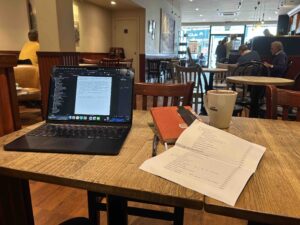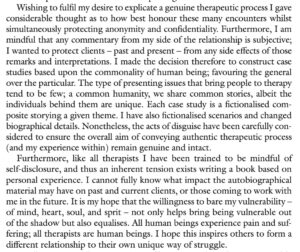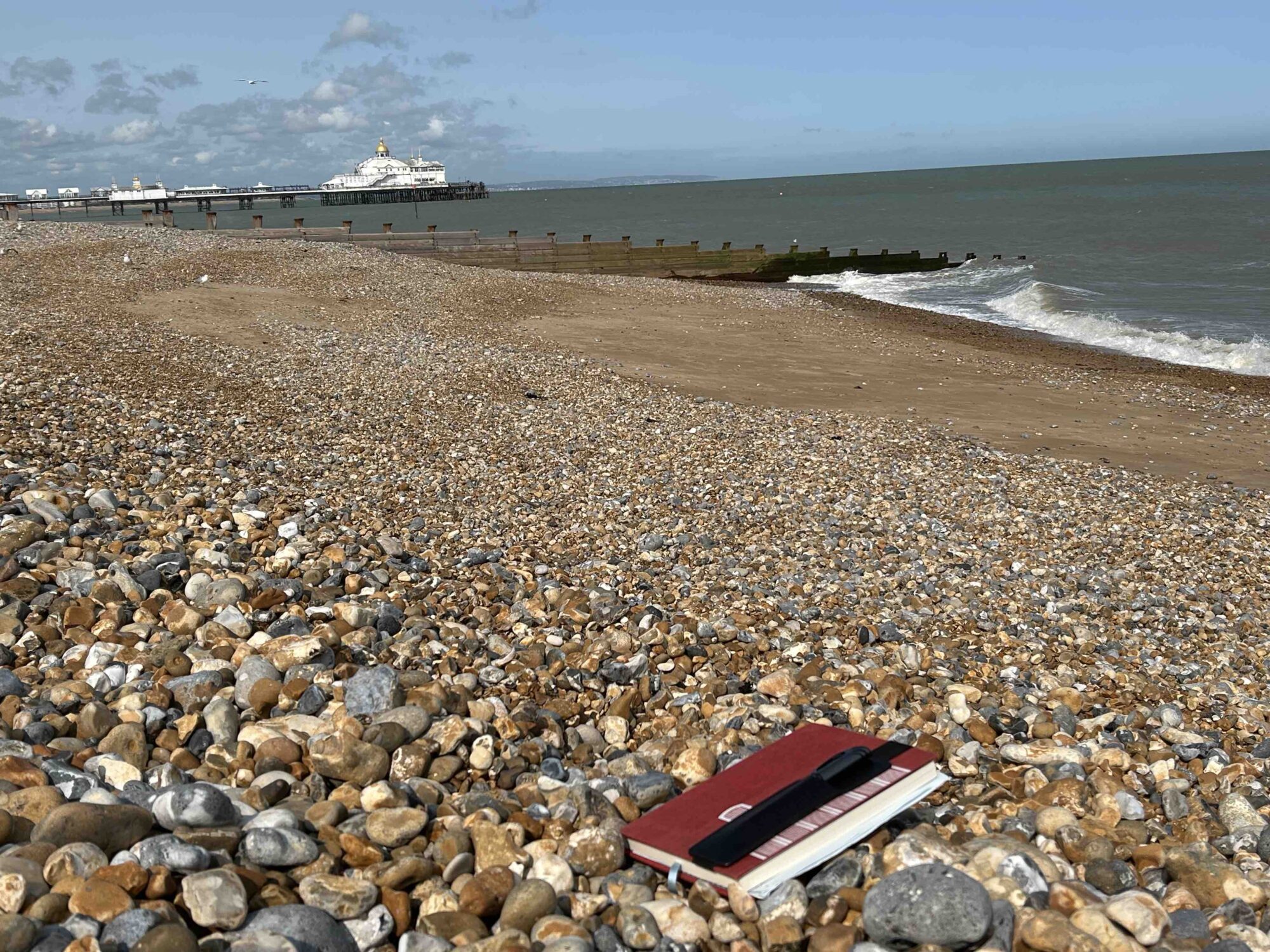Settling into my new environment, post retreat, entering the mandala…each pointing to something starting afresh, a toward becoming. The demands of spring dissolve into expectations and hopes for the summer ahead. Hence why on Wednesday this week I took myself “out on a date”, a mini writing retreat over in my old town of Eastbourne. It felt important to take myself away so that I could put aside normal life and immerse myself in writing plans – specifically Part 3 of my book project. Putting a day aside to get started announced the next stage of my working year – no teaching, only one day a week with clients…time and space is opening up, allowing re-engagement, time for reflection, the seeking of stimulation and the fulfilment from synthesis.
While on retreat last week, I connected with a sincere wish to be of service and to also create community. The writing of my book is connected to this*: the aspiration to share my experiences as a humanistic practitioner in the hope it can help others hone their craft. I know I often write about thresholds, but this book is becoming the hearth in which my own status moves along that trajectory of maiden, mother, crone: to embrace what I have to offer as a mentor, an elder. As much as I am passionate about psychotherapy, I am moving more toward the facilitating of it than the practice of it per se.
 And this feels pertinent to this present writing focus: Part 3 of a text on Humanistic Psychotherapy. Coming off the back of Part 1 (a historical and theoretical context) and Part 2 (some research I conducted exploring how the activities of counselling and psychotherapy might be differentiated), Part 3 moves into a series of essays. My writing day on Wednesday allowed the opportunity for me to cast my eye back over the themes I had generated in a brain storm last summer: 64 in total! As I moved from cafe to cafe (old and new haunts; anywhere that would house a nomad writer and their laptop), I allowed myself to re-collect the reason I had identified each theme and compiled a list of bullet points or synopsis for each. As you can imagine, there will be much overlap and interplay between ideas, so it felt important to at least define and delimit the content of each, mapping how they would all sit together with a minimum of repetition.
And this feels pertinent to this present writing focus: Part 3 of a text on Humanistic Psychotherapy. Coming off the back of Part 1 (a historical and theoretical context) and Part 2 (some research I conducted exploring how the activities of counselling and psychotherapy might be differentiated), Part 3 moves into a series of essays. My writing day on Wednesday allowed the opportunity for me to cast my eye back over the themes I had generated in a brain storm last summer: 64 in total! As I moved from cafe to cafe (old and new haunts; anywhere that would house a nomad writer and their laptop), I allowed myself to re-collect the reason I had identified each theme and compiled a list of bullet points or synopsis for each. As you can imagine, there will be much overlap and interplay between ideas, so it felt important to at least define and delimit the content of each, mapping how they would all sit together with a minimum of repetition.
My intention is to use these summer months to get through as many of the 64** as I can. Whilst I won’t publish all of them on this platform, I will use my blogging time to write, and use what I come up with for my blog. And today, I want to put fingers to keyboard and share the introduction to Part 3.
I would love your feedback and input: so as you have a read, if you have any ideas of what could be usefully included please do get in touch. As I say above, I am inspired to develop community and so any interaction and dialogue would be welcomed. A genuine teacher knows the importance of staying a student; and an elder knows receiving is as generous as giving.
Part 3: Bridging the gap: putting ideas into action
This is the pith of the book. In fact, the content we are about to dive into was the initial seed and inspiration to bring this text into being. In essence, the short essays to come represent a collection of ideas and themes that circle back to me time and time again: in the room with clients, in discussions with supervisees, and in the training environment with counselling and psychotherapy students. I think it’s fair to say that my own development as a psychotherapist took on a new trajectory when I started teaching. I have never believed the expression “those who can’t, teach”. For me, the ability to convey the principles of therapy is an art form. To be able to delve into complex philosophy, feel how the principles are lived, reflect upon the theory attempting to describe and model the human experience (as well as understand what causes distress and its healing) AND (the important bit) know that none of that is true: to be able to both teach that and to help trainees feel it and test if it feels accurate in their own experience…and in their client’s experience. A teacher of therapy is a synthesiser, a translator, a facilitator. In less education speak, she is an alchemist: she has the ability to both hold the vessel and be in the process with the group at the same time. We are not the students’ therapists; and yet our relationship with them is part of their therapeutic journey. I take that role seriously. Presenting theory in a human(e) way is therefore my main teaching compass.
When I was a trainee, I would watch and listen to my tutors; and I would come to know their own emphases and their most common teaching points (which soon became catch phrases). I am now in that position; cohorts coming to know my buzz words. It’s not long into a session when a student throws back at me the “both / and”! And so, these essays might read like a catalogue of concise expressions to be remembered in keeping with the development of the trainee’s internal supervisor. As we sit opposite the client IN relationship, developing a part of us that can also be witnessing OUTSIDE the relationship and holding ideas in mind.
I mention in this text’s opening how much of the inspiration for the style of this book, and this section in particular, was Dave Mann’s “Gestalt Therapy: 100 Key Points and Techniques”. If I can assist the humanistic practitioner as much as Mann’s text helped me with my understanding of Gestalt and applying its ideas in the room with a client…well, my job is done. In her endorsement of Mann’s text, Gestalt (and psychoanalytic therapist) Lynne Jacobs commends Mann’s “conversational style”, one that imparts the sense of a “gentle conversation with a wise elder”. THIS is exactly the manner in which I wish to conduct myself now. I do not see myself as an expert…that would be quite antithetical to this whole practice! Rather, please consider me as a companion: someone who is, like you, fascinated by psyche; someone who is, like you, motivated to help people stop hurting (themselves, others). And like Mann (or indeed the aforementioned Jim Bugental) I want to approach the writing and presentation of ideas from the attitude of therapy as both science and art. For it is the former that gives a bedrock of “theory, research and technique” so that in the room we can lead with “intuition, creativity and immediacy” (2010, pg ix). There you go, both / and!
To this end, this part of the book aims to be theory light, practice rich. Where relevant, I will refer the reader to other texts that offer a more complete discussion of the underpinning theory, or indeed, where I might have touched upon it in Parts 1 and 2. Furthermore, I hope I have been able to cross reference the short essays presented. While I have endeavoured to write each essay so it can be read as a standalone, not one of them is in isolation. This is one of the downfalls of trying to capture a three dimensional and spiral encounter in the black and white of linear prose. Read forward, read backward; repeat.

To achieve the tipped-balance-toward-practice, I endeavour to bring a range of experiences of being a human: my own personal path, my experiences as a client, sat in the “hot seat” of the therapist, and the more distanced yet experience-near explorations with supervisees and in the teaching cauldron. I will use client case material where it helps illustrate key points; and I will remind you of the attitude I take with client material (see author’s note; a sentiment I expressed in my first book).
I have arranged the essays into sections that I hope will help the reader navigate the material: and yet this I stress, was an attempt to write them in a way that offers as much support by dipping in as it is to be gained by reading sequentially:
- Self as instrument: a collection of essays that help the reader feel into their therapist-being as the tool of their trade, the vessel of the work, the vehicle of healing.
- Self, other, relationship: these essays use the “convenient fiction” of breaking down what is one, interconnected process into separate domains for ease of understanding and learning.
- Interventions: here we examine a somewhat tricky notion for the developing therapist especially in the humanistic tradition where fear of “doing to” clients is rife.
- With a little help from friends: a section paying homage not only to our ancestral roots but also to our cousins; and true to the family metaphor how much we can learn about ourselves through our relation with one another.
- Complex presentations: under this label we examine the land of diagnoses; where distress consistent with existence tips into something more intense and disturbing.
- Arriving at the cusp: here we look at the arguably natural trajectory of the humanistic through to the transpersonal view and approach
- Education and training: in this final section, I collate a few ideas to keep in mind as a therapist continues to “sharpen the saw” and master the double-edged blade of science and art.
As I finish describing the headlines for each section within which nest the series of 66 essays, it comes to mind how much this book hopes to ease some of the overwhelm I encountered as a trainee; what I observe and resonate with during facilitation of the experiential workshops, the “fish bowls” that I once drowned in. How to put the theory INTO practice. We, all therapists, need to find the conversion of ideas into action; of concepts into the percepts of lived-experience. I hold this in mind as we dive in.
———
 As I ended my day Wednesday, the Sunshine Coast invited me to move from my various nomadic dwellings to go outside and onto the beach. A most suitable end to the day and beginning to this summer spell of writing. The blue sea and sky was an invitation to open out, to expand. The literal seascape helped me tune into the intention of my writing practice for these next four months…
As I ended my day Wednesday, the Sunshine Coast invited me to move from my various nomadic dwellings to go outside and onto the beach. A most suitable end to the day and beginning to this summer spell of writing. The blue sea and sky was an invitation to open out, to expand. The literal seascape helped me tune into the intention of my writing practice for these next four months…
- To ensure this is a nourishing practice
- To engage with the processes of reading, reflecting, writing
In other words, resist the drive energy that pushes and strains (for the end product) and allow something more easeful to remain in the foreground. I will adopt the words of Henry Thoreau as my summer mantra
Life is too short to be lived in a rush
———
*plus other ideas, watch this space
**it soon became 66…just shows you should never leave me on my own, I make mischief 🙂

